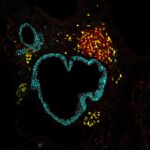
Publication: Selective predisposition to bacterial infections in IRAK-4-deficient children: IRAK-4-dependent TLRs are otherwise redundant in protective immunity.
Published in: Journal of Experimental Medicine, 2007, 204 (10), pp.2407-22. ⟨10.1084/jem.20070628⟩
Authors: Cheng-Lung Ku, Horst von Bernuth, Capucine Picard, Shen-Ying Zhang, Huey-Hsuan Chang, Kun Yang, Maya Chrabieh, Andrew C Issekutz, Coleen K Cunningham, John Gallin, Steven M Holland, Chaim Roifman, Stephan Ehl, Joanne Smart, Mimi Tang, Franck J Barrat, Ofer Levy, Douglas Mcdonald, Noorbibi K Day-Good, Richard Miller, Hidetoshi Takada, Toshiro Hara, Sami Al-Hajjar, Abdulaziz Al-Ghonaium, David Speert, Damien Sanlaville, Xiaoxia Li, Frédéric Geissmann, Eric Vivier, László Maródi, Ben-Zion Garty, Helen Chapel, Carlos Rodriguez-Gallego, Xavier Bossuyt, Laurent Abel, Anne Puel, Jean-Laurent Casanova
Summary
Human interleukin (IL) 1 receptor-associated kinase 4 (IRAK-4) deficiency is a recently discovered primary immunodeficiency that impairs Toll/IL-1R immunity, except for the Toll-like receptor (TLR) 3- and TLR4-interferon (IFN)-alpha/beta pathways. The clinical and immunological phenotype remains largely unknown. We diagnosed up to 28 patients with IRAK-4 deficiency, tested blood TLR responses for individual leukocyte subsets, and TLR responses for multiple cytokines. The patients’ peripheral blood mononuclear cells (PBMCs) did not induce the 11 non-IFN cytokines tested upon activation with TLR agonists other than the nonspecific TLR3 agonist poly(I:C). The patients’ individual cell subsets from both myeloid (granulocytes, monocytes, monocyte-derived dendritic cells [MDDCs], myeloid DCs [MDCs], and plasmacytoid DCs) and lymphoid (B, T, and NK cells) lineages did not respond to the TLR agonists that stimulated control cells, with the exception of residual responses to poly(I:C) and lipopolysaccharide in MDCs and MDDCs. Most patients (22 out of 28; 79%) suffered from invasive pneumococcal disease, which was often recurrent (13 out of 22; 59%). Other infections were rare, with the exception of severe staphylococcal disease (9 out of 28; 32%). Almost half of the patients died (12 out of 28; 43%). No death and no invasive infection occurred in patients older than 8 and 14 yr, respectively. The IRAK-4-dependent TLRs and IL-1Rs are therefore vital for childhood immunity to pyogenic bacteria, particularly Streptococcus pneumoniae. Conversely, IRAK-4-dependent human TLRs appear to play a redundant role in protective immunity to most infections, at most limited to childhood immunity to some pyogenic bacteria.
Link to HAL – hal-00297302
Link to DOI – 10.1084/jem.20070628

